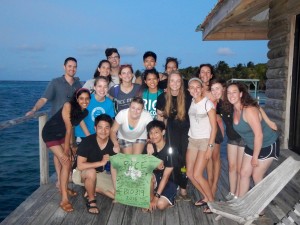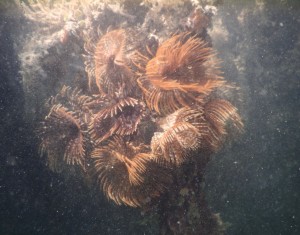One of the most striking similarities between the rainforest and the coral reef is that both are nutrient-poor environments. This seems strange considering that both are such rich in life and diversity. Contrary to popular belief, just because the soil and water are nutrient poor, doesn’t necessarily mean the environment is. It would be more accurate to say that nutrients are being constantly cycled through the many different kinds of organisms that live in the matrix. Additionally, organisms in these oligotrophic environments tend to be slow growing and have specific adaptations or symbioses that allow for greater and more efficient nutrient uptake. Both the rainforest and coral reef are complex three-dimensional networks that allow for a wide variety of physical and biochemical niches. Producers and consumers exist in a delicate balance that can be easily disrupted, a common problem when these environments are disturbed by human activities and byproducts.
In the reef especially I felt as though these conditions were most easily observable. The clear waters were an obvious indication of the oligotrophic conditions, as was the slow growth rate of coral. There were no bare surfaces and every inch of substrate was covered by coral, macroalgae, or sponge. Fish, urchins, marine worms and crustaceans filled cracks and crevices, and it seemed like every space was accounted for. In the rainforest, plants, vines and epiphytes competed for sunlight and moisture, while spiders, roaches, and ants crawled about the leaf litter. The constant activity of producers, consumers and decomposers was palatable.
This course exceeded my expectations on all accounts. I could not have imagined all of the things we got to see and do on this trip; I felt as though I finally got to really experience the reef and rainforest, as opposed to the snatches and glimpses I have received before. Partially this was due to the fact that we were able to visit places accessible only to researchers, rather than the areas that are usually overrun by tourists. I was also pleasantly surprised by the level of comfort we experienced on this trip. My time in Panama had prepared me for pasta with ketchup and spam, and stinky bucket showers. Instead we had delicious Belizan food, running water, electricity, and clean, comfortable living quarters. Also, having everything planned out for you was a real treat which let us immerse ourselves in our surroundings rather than worrying about logistics. Finally, I felt as though I had a thorough introduction to various field methods and the types of problems one might face when doing research in such an environment.
It would be hard to pick a favorite part of the course, so I’ll try to name a couple. Seeing the big cats at the zoo at night was really incredible because it was something you couldn’t see anywhere else. Sharks and rays are some of my favorite animals so seeing those on the reef made my day more than once. And, however cheesy it may be, the friendships I developed on this trip were really special. As for a least favorite, I don’t have a good answer. Sometimes trying to work on a project in such a big group was challenging and some people got their feathers ruffled while others felt they couldn’t contribute (too many cooks in the kitchen). At the same time, I felt this was a valuable lesson in collaboration and I’m not sure I would change it.
I don’t think I’ll ever forget all I learned about my taxonomic groups and topic lecture. While amphibians and annelids were never something I was interested in before, now they hold a special place in my heart. I also really value the practical knowledge I learned on this trip. Experimental design, problem solving on the spot, working smart, analyzing data in a way that reflects your research question, and my pro snorkeling skills are all things I look forward to utilizing in the future.
Sophia Streeter (certified TFB)
6/1




















